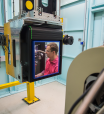
Showing 101 - 120 of 221 results
Two international agreements signed
Historic memorandums of understanding on the peaceful use of nuclear with Thailand and Canada.
Powerful collaborations using ANSTO scientific infrastructure help to improve cancer outcomes
Australian Synchrotron to officially become part of the nuclear family
Nuclear science informing risk assessments during offshore decommissioning
Environmental scientists at ANSTO have been undertaking research to gain a better understanding of the potential impact of contaminants on decommissioned offshore oil and gas infrastructure since 2017.
Eureka Prize win for Monash University and ANSTO
Recognition of research that developed a life-saving pharmaceutical milkshake using synchrotron techniques.
Connect with ANSTO's Women in STEM
Read about an ANSTO scientist and their work to prepare for a school project or interview.
Reducing, reusing and recycling mining waste
Two approaches use existing low cost and low energy technologies to reuse stockpiled waste from mining operations - capturing carbon dioxide in the form of valuable carbonate minerals.
Collaborative agreement combines extensive scientific infrastructure and expertise
Role at ANSTO
Imaging at ANSTO supported Curtin University-led research that discovered the oldest 3D heart in a 380-million-year-old fossilised fish
Researchers have discovered a 380-million-year-old heart – the oldest ever found – alongside a separate fossilised stomach, intestine and liver in an ancient jawed fish, shedding new light on the evolution of our own bodies.

Infrared microspectroscopy
The Infrared Microspectroscopy beamline combines the high brilliance and collimation of the synchrotron beam through a Bruker V80v Fourier Transform Infrared (FTIR) spectrometer and into a Hyperion 3000 IR microscope to reach high signal-to-noise ratios at diffraction limited spatial resolutions between 3-8 μm.

Role at ANSTO
Role at ANSTO
Australia’s Nuclear Age Celebrates 70 Years
Deciphering the complex molecular activity that leads to cell death
Research on the mechanism of cell death has insights to bring progress on neurodegenerative diseases and plant biosecurity.

High Performance Macromolecular Crystallography Beamline (MX3)
The High Performance Macromolecular Crystallography beamline will enable the study of very small (sub-5 micrometre) or weakly diffracting crystals, providing a state-of-the-art high-throughput facility for researchers. MX3 will be able to study the structures of large proteins and protein complexes for virology, drug design and industrial applications via goniometer mounted crystals, in-tray screening, or via serial crystallography methods.
Australian Synchrotron celebrates 20,000 research partnerships

ANSTO Australian Synchrotron User Advisory Committee (UAC)
The User Advisory Committee (UAC) is an independent group that provides advice to ANSTO Australian Synchrotron (AS) senior management on issues from a user perspective.
ANSTO fights cancer
Commitment to undertake health research.